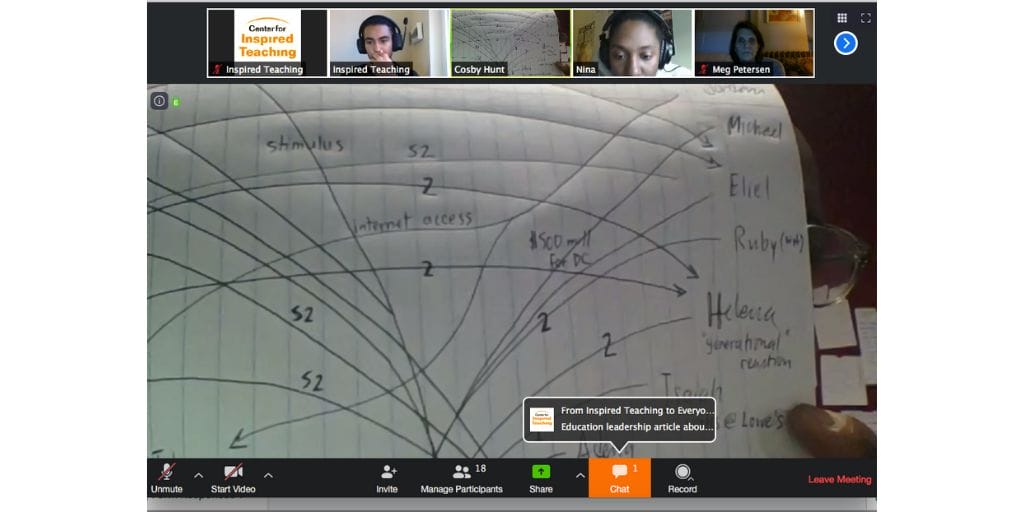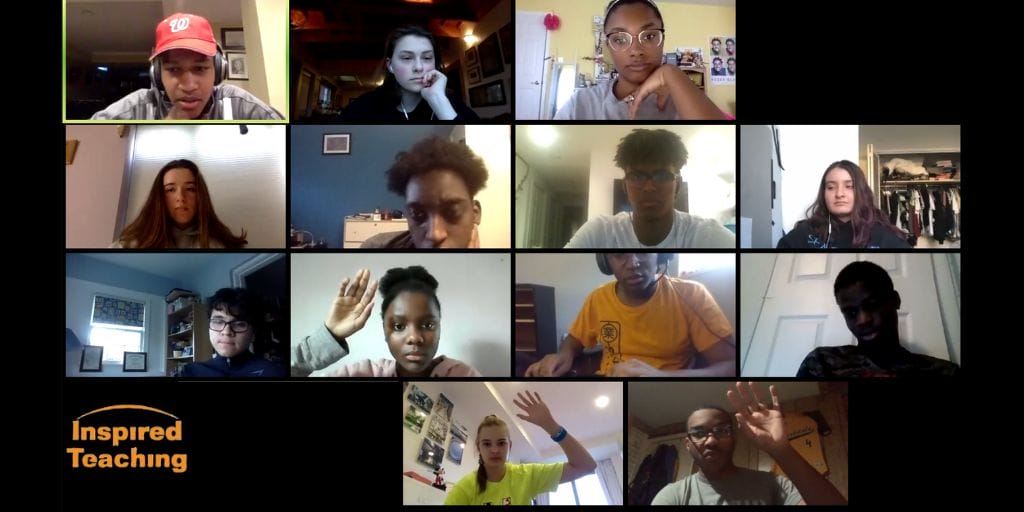At a time when we’re craving in-person conversations and missing the flow that body language can bring to a discussion, Inspired Teaching’s Speak Truth virtual sessions offer a beautiful antidote to all the things we’re growing fond of bemoaning about video conferencing.
It turns out that well-structured, student-led discussions can be effective both in-person AND online because the elements that make them work in a physical space actually translate pretty well to a virtual one.
As Inspired Teacher Cosby Hunt opened the session last Thursday on ZOOM he explained, “Student led discussions are the way things should happen more often in our classrooms. We can be starting student-led discussions even while we’re at home.” He was speaking to a group of about 40 teachers and students who represented schools from up and down the Eastern Seaboard ranging from high school students and their teachers from DC and MD public, private, and charter schools to students and preservice teachers from rural New Hampshire.
The discussion began and was facilitated entirely by Alejandro Rojas, a sophomore at Georgetown Prep High School in Bethesda, MD. The topic students would debate for the next hour was: Is the novel Coronavirus exacerbating inequality? Alejandro did a stunning job of keeping the discussion flowing with questions he’d prepared ahead of time, visuals he shared to set up new lines of inquiry, and an effort to balance the voices present so everyone who wanted to jump in could do so. Here is a sampling of the questions discussed:
- Have people overreacted or underestimated the magnitude of this virus?
- How can this inequality manifest itself in the nationwide switch to online school?
- What types of workers are facing unemployment? Is it fair to say that those of low-income working jobs are disproportionately affected?
- How will this pandemic change how the government spends money?

During the discussion, Alejandro shared a map of where emergency rooms are located throughout the country.
In a conversation with teachers after the student discussion had ended, Inspired Teaching instructor Max Peterson explained the process he follows with students who choose to facilitate Speak Truth sessions. The students choose the focus. Then Max serves as a guide on the side, coaching student-facilitators to think about what questions will foster the greatest level of engagement, what activities, interspersed throughout the discussion, will offer opportunities for students to learn more about each other, and how to structure the overall discussion so participants feel heard and the topic is fully explored. “I leverage their interest in the topic to make sure that they work hard on prepping the outline . . . we want to maximize students’ agency and build on what they bring so their expertise really shines.”
The format online and in person is roughly the same, and includes these key components:
- The opportunity for all students present to share who they are, where they go to school, and something of interest about them that will help attendees to quickly gain some common understanding/ground.
- An introduction of the topic with some foregrounding by the student-facilitator, compelling scholarly readings are given to participants ahead of time to help set the stage for the discussion.
- Thought provoking questions are asked that guide participants from less controversial ideas to those that challenge thinking more, easing the group into comfort with discomfort.
- Activities may be used to further establish where participants are in relation to the topic geographically, politically, socioeconomically, etc. Again, these are always facilitated by the student leader so a high level of mutual trust is maintained.
- Efforts are made to hear from a wide variety of voices so no one person dominates the discussion. While this can be more difficult to manage in an online space with multiple video screens to manage, a “conversation chart” like the one below can serve as a good tool for observing and supporting participation.
- A closing question synthesizes the contributions of participants and offers and opportunity for final thoughts.
Speak Truth sessions reflect the core elements of the Inspired Teaching approach. Students are the central experts. Their intellect, imagination, integrity, and inquiry drive the whole discussion. And as teachers, putting them in the driver’s seat for the discussion reflects a high level of mutual respect that they in turn learn to show one another.

Cosby shared a picture of the discussion map he draws during the conversation to keep track of who is participating and how the conversation flows. He uses these notes to offer students feedback after the discussion is over.
In Thursday’s session only a handful of participants knew each other in advance, and yet the discussion got deep very quickly with students sharing their own personal perspectives on the relationship between wealth, power, and race in coronavirus response and ramifications.
For example, in response to a question about whether education is right in the United States, Ishaan from the Maret School in Washington, DC replied, “Not necessarily. As the government does not have any legislation pertaining to explicit human rights regulations, things like the internet for education are often left in the dust. I’d say the government views education as non-essential and therefore internet connection as an extension of that view.”
The points made by the assembled students who ranged from freshmen to seniors in high school were worthy of the most esteemed Sunday morning talk shows and the adults who joined the discussion just to listen shared their amazement after the conversation with the level of sophistication and thoughtfulness on display.
As teachers experiment to find the best way to make use of video-time with students, the Speak Truth model is definitely worth exploring. There is a growing consensus that distance learning cannot replicate what we do in a typical school day and that the emphasis should be less on time spent vs. quality of that time. Having students plan meaningful discussions that you observe as they take place offers both a leadership opportunity for the students and tremendous learning opportunity for you as the teacher.

